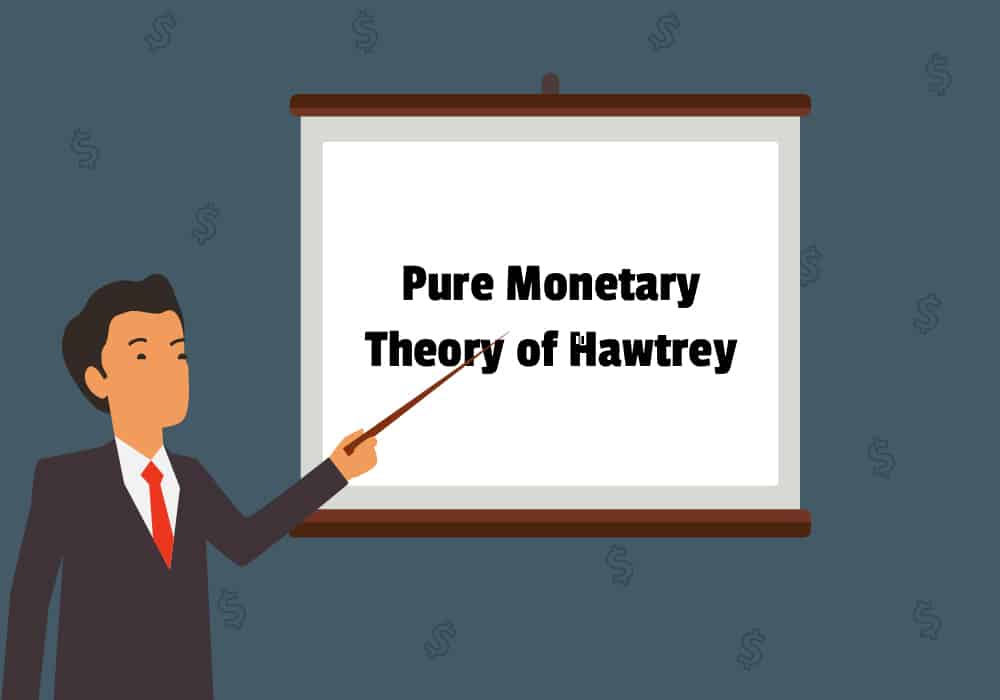The pure monetary theory of Hawtrey

R. G. Hawtrey states that the trade cycles as a purely monetary phenomenon so the ups and downs of economic activity is being controlled by the money flow of the situation. In this sense that all that occurred changes in the level of economic activity are nothing but reflections of changes in the flow of money. Thus, Hawtrey holds positively to the view that the causes of cyclical fluctuations were to be found only in those factors that produce expansions and contractions in the flow of money — money supply. Hence, the ultimate cause of economic instabilities lies in the monetary system.
According to Hawtrey, the main reason affecting the flow of money — money supply — is the credit creation by the banking system. To him, changes in income and spending are produced by changes in the volume of bank credit. The real causes of the trade cycle can be traced to variations in effective demand which happen due to changes in bank credit. Therefore, by his words “the trade cycle is a monetary phenomenon, because general demand is itself a monetary phenomenon.”
In his opinion, the duration and the extent of the trade cycle are determined by the rate of progress of credit development. Thus, “when credit movements are fast-tracked, the period of the cycle is shortened.” This suggests that if credit facilities do not be present, variability does not occur. So, by governing credit, one can regulate fluctuations in economic activity.
He further continues that although the rate of progress of cycles may be subjected to non-monetary causes, these factors operate indirectly and through the medium of the credit movement. For example, a non-monetary feature such as optimism in a particular industry can touch activity directly, but it cannot employ a general influence on the industry unless optimism is allowed to echo itself through economic changes, i.e., through increased borrowing. On these grounds, Hawtrey viewed trade cycle as a purely monetary phenomenon.
The core of the pure monetary theory is that the inherent instability in bank credit grounds changes in the flow of the money which in effect leads to cyclical deviations. Economic expansion is caused by the expansion of bank credit and the economic catastrophe rises no sooner the credit creation is stopped by the banking system; thus, a contraction of credit leads to a recession.
Hawtrey’s sequence of the trade cycle is based upon following postulates:
1.The consumers’ income is the aggregate of money income=national income or community’s income in general.
2.The consumers’ expenditure is the aggregate of money spending’s on consumption and investment
3.The consumers’ total expenditure creates the community’s aggregate effective demand for real goods and services. Thus, general demand is a monetary demand.
4.The suppliers or traders have a strategic position in the economy. They are exceedingly sensitive in their stock hoarding business to the changes in the rate of interest.
5.The changes in the flow of money are generally caused by the unsteady nature of bank credit. Hence, bank credit has an exclusive significance in Hawtrey’s cyclical model.
According to Hawtrey, changes in business activity are due mainly to differences in effective demand or consumers’ expenditure. It is the total money income that regulates consumers’ expenditure. The steadiness of the whole economic system follows from the establishment of monetary equilibrium.
Under monetary equilibrium
-
Consumers’ expenditure = consumers’ income;
-
Consumption = production;
-
Cash balances of consumers and dealers remain unchanged;
-
Bank credit flow is stable;
-
The market rate of interest = the profit rate;
-
Wages (as money costs) and prices, on the whole, are equal (this means normal profit margin and the normal rate of productive activity); and
-
There is no net export or import of gold.
Hawtrey opposes that such a monetary equilibrium situation is one of extremely delicate balance, which can be easily disrupted by any number of causes and when disturbed, tends to move into a transitional period of cumulative disequilibrium.
He highlighted that primarily it is the unbalanced nature of the credit system in the economy that causes changes in the flow of money and disturbs the monetary equilibrium. In this connection, he senses that the discount rate or interest rate exerts a great influence.
The Expansion Stage:
A classic expansion phase, according to Hawtrey, might proceed along the following lines.
The expansion phase of the trade cycle is carried about by an increase of credit and lasts so long as the credit expansion goes on. Credit expansion is carried about by banks through the easing of loaning conditions along with a drop in the discount rate, thereby reducing the costs of credit.
By dropping their lending rates, banks encourage borrowing. Such a reduction in the interest rate is a great stimulus to wholesalers (or traders). According to Hawtrey, traders are in a tactical position as they have a habit to carry their large stocks largely with borrowed money.
Furthermore, traders usually mark their profits as a fraction of the value of a large turnover of goods. Hence, a small change in the interest rate affects their profits to a disproportionately large extent. Thus, they are very sensitive to change in the rate of interest.
Traders are encouraged to increase their stocks — inventories— when the interest rate falls. Hence, they give large order to the producers; the increased orders of traders cause the producers to raise their level of production and employment. This in turn leads to an increase in income and monetary demand.
“Thus the whole amount of the funds generated by the bank is received as income, whether profits, wages, rents, salaries, or interest, by those engaged in producing the commodities.” Evidently, the increased production leads to an expansion of consumers’ income and outlay.
This means increased demand for goods in general, and traders find their stocks shrinking. These result in further orders to manufacturers, a further increase in productive activity, in consumers’ income and expenditure, and in demand, and further depletion of stocks. Improved activity means better demand, and better demand means increased activity.” This leads to a cumulative expansion, set up, fed and propelled by the continuous expansion of bank credit.
He continuously argues, “Productive activity should be confined and it cannot grow without limit. As the increasing process brings one industry after another to the limit of productive capacity, manufacturers begin to quote greater and greater prices.” Thus, when prices rise, dealers have a further incentive to borrow and hold more stocks in view of the increased profits.
The cumulative expansion will be accelerated further because the rising prices operate in the same way as falling interest rates. This means that there are three significant factors which influence credit expansion by banks. These are:
♦The rate of interest charged by the banks
♦Traders’ expectations about the price behavior
♦The real magnitude of their sales
The interest rates will be decided by banks. Dealers’ expectations depend on general business situations and their psychology. The real magnitude of sales depends on the net effect of the first two upon the consumers’ expenditure. In brief, “optimism leads to take borrowing, borrowing give acceleration to sales, and sales quicken optimism”.
Financial Crisis (Recession):

Hawtrey says that richness comes to an end when credit expansion ends.
As banks go on increasing credit, their cash funds exhaust and they are forced to limit credit and raise interest rates in order to discourage the demand for new loans. Because of the shortage of gold reserves, the central bank — as a financier of the last resort — has to fix a limit on the accommodation to commercial banks.
Finally, the central bank will start contracting credit by raising the bank rate. Thus, the drain of cash from the banking system eventually results in an acute shortage of bank ‘reserve’, so that the banks not only refuse to lend any more but actually are compelled to contract.
According to Hawtrey, a problem upon the cash reserves of the banking system is caused by the public. For an increase in buyers’ income generally would lead to an increase in the cash holding by the public.
This happens when the wages rise and so wage-earners’ demand for cash rises. Thus, what finally limits the expansion of credit is the absorption of money in circulation, mainly by wage-earning classes.
Besides, under the international gold standard, if expansion is taking place quickly in a country, it will lose gold to other countries due to too many imports. Eventually, the central bank will have to implement a defensive policy.
The declining phase merges with depression due to the growing shortages of credit. The contraction of credit exerts a deflationary force on prices and profits and on consumers’ income and expenditure. The high rate of interest charged by banks discourages traders to hold large stocks and their demand for credit drops. Prices start falling, profits also fall.
Recovery

Search for different types of arrow PowerPoint templates
During a recession, as traders experience break in the demand for their goods, they will try to dispose of goods at whatever low price they get and repay bank’s mortgages. When loans are settled, money gradually flows from the circulation into the reserves of the bank. As the recession continues, banks will have more and more idle reserves. The central bank now supports by lowering the bank rate and accepts open market purchases of securities so that cash is pumped into banks improving their lendable resources.
In Hawtrey’s view, this cyclical action is basically a monetary phenomenon. He does not refute that non-monetary causes (such as discovery, innovation, bumper crops, etc.) may affect productive activity but he feels that their effects will be synchronized only with monetary effects. Non-monetary causes have no periodicity; the periodicity that seems in trade cycles is due to fiscal effects, and it can be overcome by proper banking policy.
Conclusion
Hawtrey’s theory is flawlessly logical in its basic concept of a self-generating cycle of a cumulative process of expansion and contraction. One of the most prominent features of Hawtrey’s theory is his description of the period of a cycle, i.e., his explanation of the turning points of expansion and contraction. Central bank’s monetary policies have a massive impact on the nation’s economic condition because of credit availability. These also determined by the price mechanisms. However, Hawtrey’s theory is not beyond criticism, he always exaggerating the importance of wholesalers, not mentioning the capital goods industries and all other sectors of the economy.
Some opponents have pointed out that monetary inflation and deflation are not causes, as Hawtrey explains, but the result of trade cycles. In fact, credit expansion follows business expansion, and once it takes place, it would quicken business activity. So, monetary deflation is led by business contraction.
The role of bank credit in the economic system is the predominant aspect of Hawtrey’ss theory. It is true that finance is the pillar of business and bank credit plays a significant role in it, but it does not mean that banks are always the leaders of economic activity.
Hawtrey states that changes in the flow of money are the sole and adequate cause of economic variations. But, a trade cycle, being a compound phenomenon, cannot be attributed to a single cause. There are numerous nonmonetary native and international factors, besides monetary factors which influence economic activity. Thus, it is incorrect to say that trade cycles are a purely monetary phenomenon.


